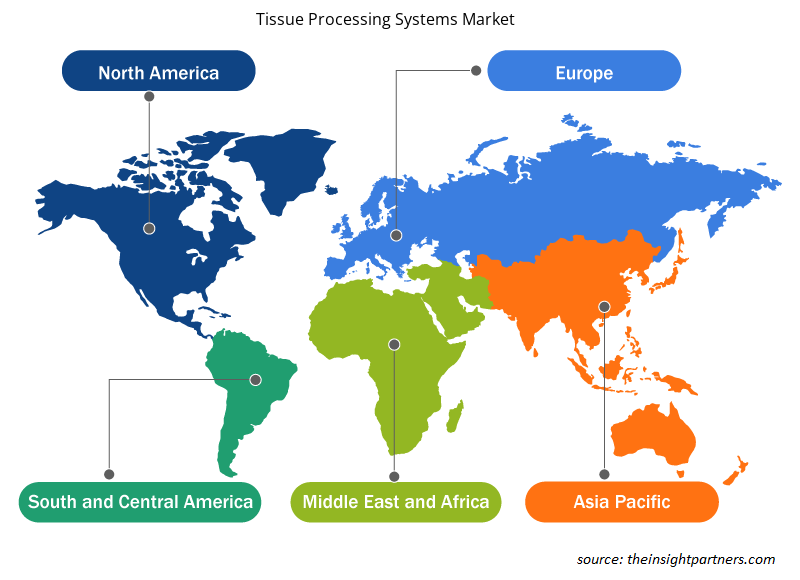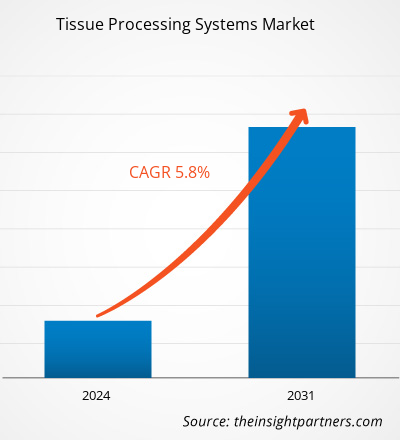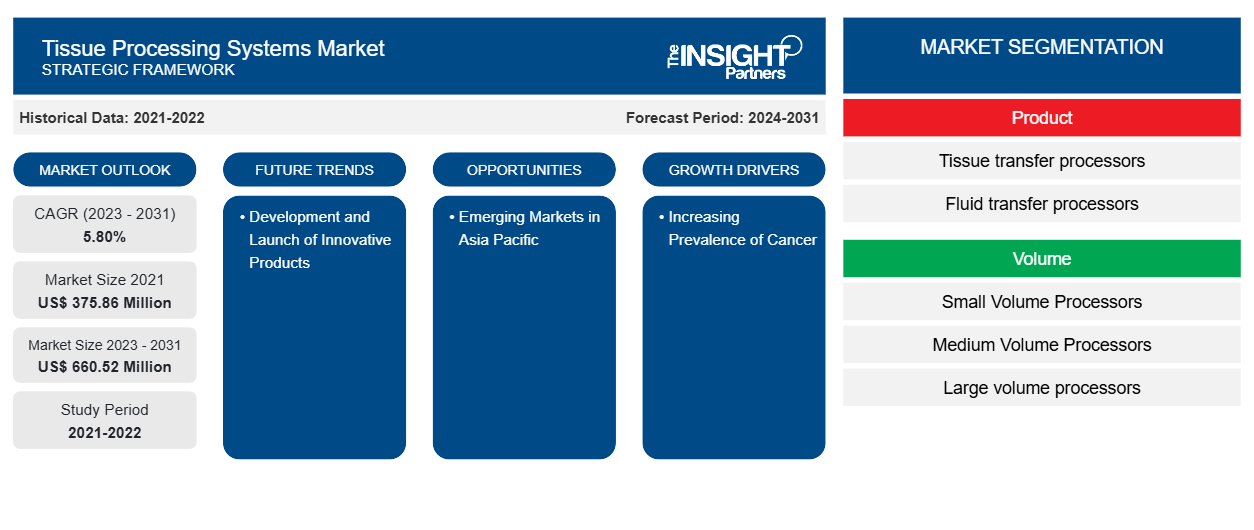Il mercato dei sistemi di elaborazione dei tessuti è stato stimato in 375,86 milioni di dollari USA nel 2021 e xx milioni di dollari USA nel 2023. Si prevede che raggiungerà 660,52 milioni di dollari USA entro il 2031 e registrerà un CAGR del 5,80% fino al 2031. Le mutevoli preferenze dei consumatori e i progressi tecnologici rimarranno probabilmente le tendenze chiave del mercato dei sistemi di elaborazione dei tessuti.
Analisi di mercato dei sistemi di elaborazione dei tessuti
Si prevede che la crescente prevalenza del cancro guiderà la crescita del mercato dei sistemi di elaborazione dei tessuti. Si prevede che la crescente prevalenza del cancro aumenterà la domanda di sistemi di elaborazione dei tessuti per la diagnosi. Secondo l'agenzia per il cancro dell'Organizzazione mondiale della sanità (OMS), l'Agenzia internazionale per la ricerca sul cancro (IARC), nel 2022 si sono verificati circa 20 milioni di nuovi casi di cancro e circa 9,7 milioni di decessi.
Panoramica del mercato dei sistemi di elaborazione dei tessuti
Il mercato globale dei sistemi di elaborazione dei tessuti è segmentato per regione in Nord America, Europa, Asia Pacifico, Medio Oriente e Africa e Sud e Centro America. La crescita del mercato in questa regione è prevista a causa di fattori quali la crescente prevalenza del cancro e il crescente numero di laboratori diagnostici . Tuttavia, si prevede che l'elevato costo della diagnostica del cancro ostacolerà la crescita del mercato in una certa misura durante gli anni di previsione.
Personalizza questo report in base alle tue esigenze
Riceverai la personalizzazione gratuita di qualsiasi report, comprese parti di questo report, o analisi a livello nazionale, pacchetto dati Excel, oltre a usufruire di grandi offerte e sconti per start-up e università
-
Scopri le principali tendenze di mercato in questo rapporto.Questo campione GRATUITO includerà analisi di dati che spaziano dalle tendenze di mercato alle stime e alle previsioni.
Driver e opportunità di mercato dei sistemi di elaborazione dei tessuti
Aumento del numero di laboratori diagnostici per favorire il mercato.
C'è un aumento nel numero di laboratori diagnostici, dovuto all'aumento delle condizioni croniche. L'aumento delle condizioni croniche, come cancro, diabete e malattie cardiache, porta a una maggiore domanda di servizi diagnostici. I Centers for Medicare & Medicaid Services regolano tutti i test di laboratorio eseguiti sugli esseri umani negli Stati Uniti tramite Clinical Laboratory Improvement Amendments (CLIA). CLIA ha circa 317.545 laboratori registrati (Esenti/Non Esenti) a marzo 2024. Inoltre, la presenza di importanti laboratori diagnostici negli Stati Uniti probabilmente favorirà la crescita del mercato. Ad esempio, Quest Diagnostics è leader nel settore della diagnostica medica che offre servizi diagnostici negli Stati Uniti. È la rete più estesa negli Stati Uniti, con oltre 7.400 punti di accesso per i pazienti, che includono flebotomi negli studi medici e oltre 2.250 centri di assistenza ai pazienti.
Mercati emergenti nell’area Asia-Pacifico: un’opportunità nel mercato dei sistemi di elaborazione dei tessuti
I mercati emergenti nei paesi in via di sviluppo nella regione Asia-Pacifico stanno creando migliori opportunità per importanti attori del mercato di espandere il loro business. Questa è una delle ragioni principali della crescita del mercato nel periodo di previsione. La maggior parte degli attori principali si concentra sui mercati emergenti, come India e Cina, a causa del gran numero di pazienti oncologici e dell'aumento del turismo medico nei paesi in via di sviluppo. Molti dei paesi emergenti sono una sede preferita per il turismo medico.
Secondo il Globocan 2022: India Factsheet, nel 2022 si sono verificati 1.413.316 nuovi casi di cancro e 916.827 decessi per cancro. Inoltre, l'aumento del turismo medico nei paesi emergenti e la crescente prevalenza di condizioni croniche nella regione probabilmente forniranno significative opportunità di crescita agli operatori che operano nel mercato durante il periodo di previsione.
Analisi della segmentazione del rapporto di mercato sui sistemi di elaborazione dei tessuti
I segmenti chiave che hanno contribuito alla derivazione dell'analisi di mercato dei sistemi di lavorazione dei tessuti sono i servizi e le applicazioni.
- In base al prodotto, il mercato dei sistemi di elaborazione dei tessuti è segmentato in processori di trasferimento dei tessuti e processori di trasferimento dei fluidi. Il segmento dei processori di trasferimento dei fluidi deteneva la quota maggiore del mercato, mentre si prevede che il segmento dei processori di trasferimento dei tessuti registrerà il CAGR più elevato nel mercato durante il periodo di previsione.
- Il mercato è segmentato in base al volume in processori di piccolo volume, processori di medio volume e processori di grande volume. Il segmento di piccolo volume ha detenuto la quota maggiore del mercato nel 2023. Tuttavia, si prevede che il segmento di medio volume registrerà il CAGR più elevato nel mercato durante il periodo di previsione.
- In base all'utente finale, il mercato dei sistemi di elaborazione dei tessuti è stato segmentato in ospedali, aziende farmaceutiche, laboratori di ricerca e altri. Il segmento degli ospedali deteneva la quota maggiore del mercato, mentre si stima che il segmento delle aziende farmaceutiche registrerà il CAGR più elevato nel mercato durante il periodo di previsione.
Analisi della quota di mercato dei sistemi di elaborazione dei tessuti per area geografica
L'ambito geografico del rapporto di mercato sui sistemi di lavorazione dei tessuti è suddiviso principalmente in cinque regioni: Nord America, Asia Pacifico, Europa, Medio Oriente e Africa e Sud America/Sud e Centro America.
Il Nord America comprende Stati Uniti, Canada e Messico. Il mercato del Nord America ha detenuto una quota significativa del mercato globale durante l'anno 2023. Si prevede che la domanda per il mercato nella regione registrerà una crescita a un tasso significativo durante il periodo di previsione a causa di vari fattori come la crescente prevalenza del cancro, insieme alla crescente consapevolezza riguardo alla condizione di salute cronica e alla presenza di associazioni di supporto nella regione. C'erano molte organizzazioni coinvolte negli investimenti e nella creazione di consapevolezza riguardo al cancro e alla sua diagnosi.
L'Asia Pacifica è il mercato in più rapida crescita per i sistemi di elaborazione dei tessuti in uno scenario globale a causa dell'invecchiamento della popolazione, dell'aumento dei casi di cancro, dei progressi tecnologici e delle crescenti iniziative governative per offrire un'assistenza sanitaria avanzata a prezzi accessibili, e del numero crescente di startup e aziende di dispositivi medici in questa regione. Inoltre, l'aumento dell'incidenza e dei tassi di mortalità del cancro, le attività di ricerca nella regione e la presenza di associazioni o organizzazioni che migliorano la qualità dell'assistenza nel cancro contribuiscono anche alla crescita del mercato.
Approfondimenti regionali sul mercato dei sistemi di elaborazione dei tessuti
Le tendenze regionali e i fattori che influenzano il mercato dei sistemi di elaborazione dei tessuti durante il periodo di previsione sono stati ampiamente spiegati dagli analisti di Insight Partners. Questa sezione discute anche i segmenti e la geografia del mercato dei sistemi di elaborazione dei tessuti in Nord America, Europa, Asia Pacifico, Medio Oriente e Africa e America meridionale e centrale.

- Ottieni i dati specifici regionali per il mercato dei sistemi di elaborazione dei tessuti
Ambito del rapporto di mercato sui sistemi di elaborazione dei tessuti
| Attributo del report | Dettagli |
|---|---|
| Dimensioni del mercato nel 2021 | 375,86 milioni di dollari USA |
| Dimensioni del mercato entro il 2031 | 660,52 milioni di dollari USA |
| CAGR globale (2023-2031) | 5,80% |
| Dati storici | 2021-2022 |
| Periodo di previsione | 2024-2031 |
| Segmenti coperti |
Per Prodotto
|
| Regioni e Paesi coperti |
America del Nord
|
| Leader di mercato e profili aziendali chiave |
|
Densità degli attori del mercato dei sistemi di elaborazione dei tessuti: comprendere il suo impatto sulle dinamiche aziendali
Il mercato dei sistemi di elaborazione dei tessuti sta crescendo rapidamente, spinto dalla crescente domanda degli utenti finali dovuta a fattori quali l'evoluzione delle preferenze dei consumatori, i progressi tecnologici e una maggiore consapevolezza dei vantaggi del prodotto. Con l'aumento della domanda, le aziende stanno ampliando le loro offerte, innovando per soddisfare le esigenze dei consumatori e capitalizzando sulle tendenze emergenti, il che alimenta ulteriormente la crescita del mercato.
La densità degli operatori di mercato si riferisce alla distribuzione di aziende o società che operano in un particolare mercato o settore. Indica quanti concorrenti (operatori di mercato) sono presenti in un dato spazio di mercato in relazione alle sue dimensioni o al valore di mercato totale.
Le principali aziende che operano nel mercato dei sistemi di elaborazione dei tessuti sono:
- Agilent Technologies Inc.,
- Laboratori Biogenex,
- Sakura Finetek Usa Inc.,
- Thermo Fisher Scientific Inc.,
- F. Hoffmann-La Roche AG,
- Siemens Ag,
Disclaimer : le aziende elencate sopra non sono classificate secondo un ordine particolare.

- Ottieni una panoramica dei principali attori del mercato dei sistemi di elaborazione dei tessuti
Notizie di mercato e sviluppi recenti sui sistemi di elaborazione dei tessuti
Il mercato dei sistemi di elaborazione dei tessuti viene valutato raccogliendo dati qualitativi e quantitativi dopo la ricerca primaria e secondaria, che include importanti pubblicazioni aziendali, dati di associazioni e database. Di seguito è riportato un elenco degli sviluppi nel mercato dei sistemi e delle strategie di elaborazione dei tessuti:
- Nell'agosto 2023, Sakura Finetek USA ha lanciato due nuovi prodotti a marchio Tissue-Tek Genie che consentono il test CISH sul sistema di colorazione avanzata Tissue-Tek Genie. (Fonte: comunicato stampa aziendale)
- Nel febbraio 2023, Clarapath, un'azienda di robotica, ha acquisito Croscope. L'acquisizione combina SectionStar di Clarapath, il primo sistema di sezionamento e trasferimento dei tessuti completamente automatizzato e all-in-one, con il flusso di lavoro e gli strumenti di patologia computazionale di Croscope, consentendo ai laboratori di fornire assistenza in modo più rapido, più conveniente e con una qualità superiore. (Fonte: comunicato stampa aziendale)
Copertura e risultati del rapporto di mercato sui sistemi di elaborazione dei tessuti
Il rapporto "Dimensioni e previsioni del mercato dei sistemi di elaborazione dei tessuti (2021-2031)" fornisce un'analisi dettagliata del mercato che copre le seguenti aree:
- Dimensioni e previsioni del mercato a livello globale, regionale e nazionale per tutti i segmenti di mercato chiave coperti dall'ambito
- Dinamiche di mercato come fattori trainanti, vincoli e opportunità chiave
- Principali tendenze future
- Analisi dettagliata delle cinque forze PEST/Porter e SWOT
- Analisi di mercato globale e regionale che copre le principali tendenze di mercato, i principali attori, le normative e gli sviluppi recenti del mercato
- Analisi del panorama industriale e della concorrenza che copre la concentrazione del mercato, l'analisi della mappa di calore, i principali attori e gli sviluppi recenti
- Profili aziendali dettagliati
- Analisi storica (2 anni), anno base, previsione (7 anni) con CAGR
- Analisi PEST e SWOT
- Valore/volume delle dimensioni del mercato - Globale, Regionale, Nazionale
- Industria e panorama competitivo
- Set di dati Excel
Report recenti
Testimonianze
Motivo dell'acquisto
- Processo decisionale informato
- Comprensione delle dinamiche di mercato
- Analisi competitiva
- Analisi dei clienti
- Previsioni di mercato
- Mitigazione del rischio
- Pianificazione strategica
- Giustificazione degli investimenti
- Identificazione dei mercati emergenti
- Miglioramento delle strategie di marketing
- Aumento dell'efficienza operativa
- Allineamento alle tendenze normative























 Ottieni un campione gratuito per - Mercato dei sistemi di elaborazione dei tessuti
Ottieni un campione gratuito per - Mercato dei sistemi di elaborazione dei tessuti